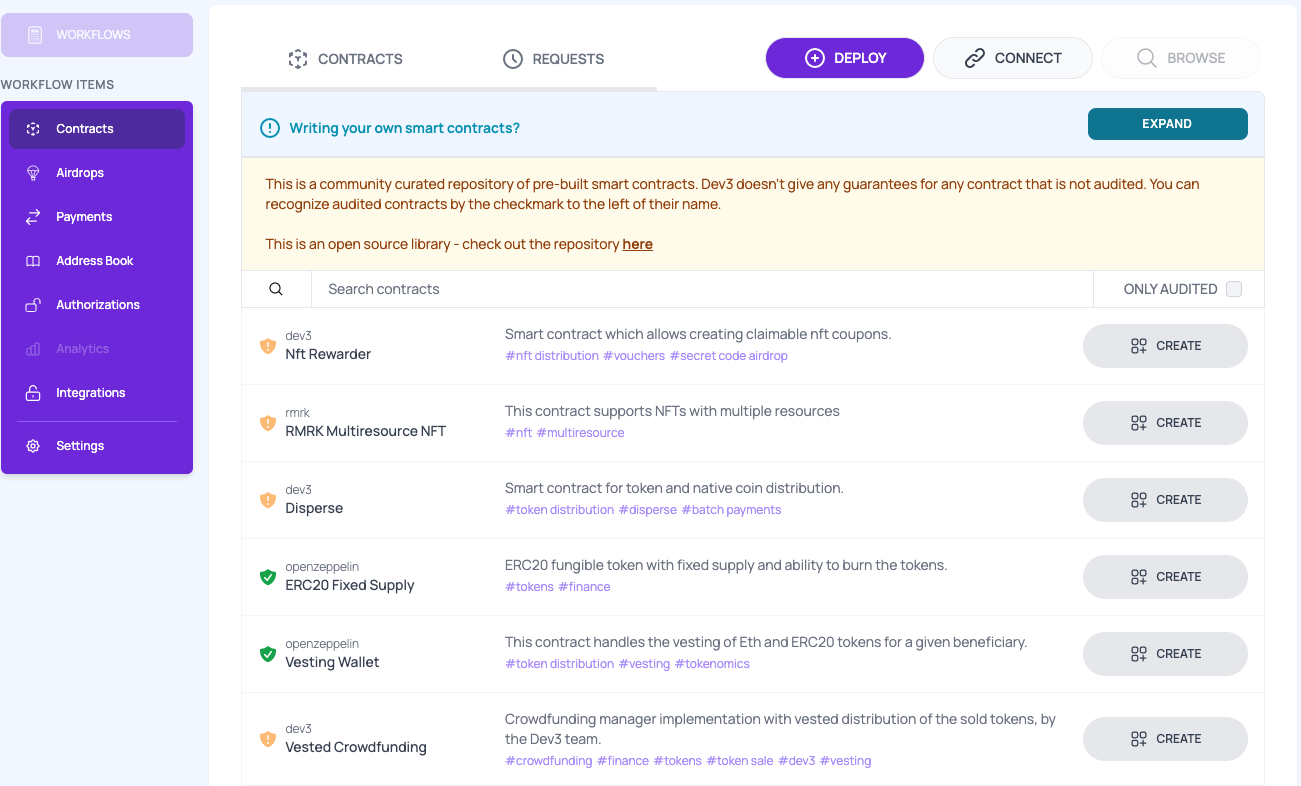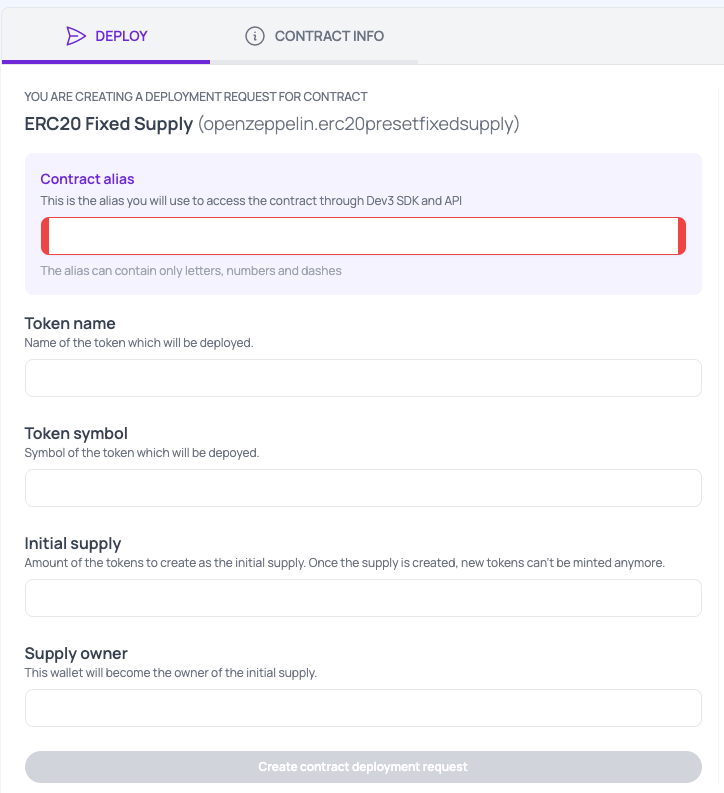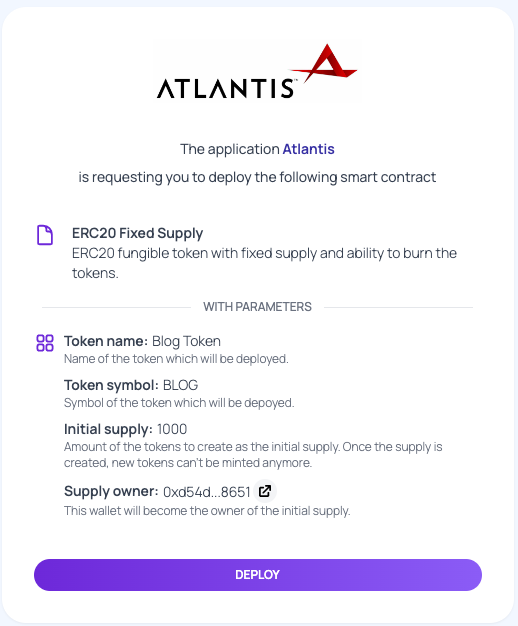Blockchain dominates the world since its technology produces the current most well-known virtual currency, Bitcoin. Many think of Bitcoin as the very mention of Blockchain. However, lately, Ethereum has taken the stage because it goes beyond Bitcoin by offering a virtual machine and smart contracts that allow users to deploy tokens, while Bitcoin simply depends on currencies.
A token is a virtual money, a lottery ticket, assets we can trade, etc. On the Ethereum blockchain, you may create a variety of tokens, but today we will concentrate on how to deploy ERC20 tokens with Dev3 without coding.
What Is Blockchain and How Does It Work?
Blockchain is a shared, decentralized database that facilitates the process of recording transactions and tracking assets in the network.
What is essential to understand is the decentralized nature of Blockchain as a concept. The fact that practically for the first time in history, we have a way to store and verify data over which no individual body has control is one of the main reasons for the revolution we are witnessing.
In this sense, Blockchain practically enables the complete democratization of some of the world’s most important industries, primarily financial. Each completed transaction is assigned a time stamp, while the transaction itself is chronologically added to the existing chain of blocks and connected to it. It’s a series containing data about each transaction carried out within it. The only thing left is to wait for some more time and see what changes await us at the global level.
What Is Ethereum and How Does It Work?
When discussing blockchain networks, we can’t help but mention Ethereum as a popular blockchain network. It allows any developer to encrypt any decentralized application and run it on the Blockchain. The system is based on using tokens, which can be sold, bought, and transferred. All of this runs on Ether, the native token of Ethereum, and this token is used to pay miners’ fees such as, transaction fees on the network., and many other network services, such as smart contracts.
One of Ethereum’s most important goals is to create an ecosystem that seamlessly connects everything, creating its vision of a “global network.” It’s not just about the network, Blockchain, and apps, but also about the tokens needed to sustain the entire ecosystem. Since its inception in 2014, Ethereum has been working towards this goal, and one of the main innovations it has introduced is ERC20 tokens. These tokens can now be created as part of the Ethereum ecosystem.
ERC20 Standard
In addition to creating tokens that work with the Ethereum Blockchain, there is also a standard created around Ethereum tokens called the ERC20 standard. The standard means that new tokens are made to be compatible with the existing network, and the new token must follow a set of rules for this to happen. It defines general rules or values that must be included in all tokens created in Blockchain Ethereum and allows developers, exchanges, and other smart contracts to know how the new token will behave.
What is an ERC20 Token?
In this paragraph, we will talk about fungible tokens – ERC20 tokens. They are created on the Ethereum blockchain and represent digital assets that have value and can be interchanged with another token. On the Ethereum network, these tokens can be generated via smart contracts.
What Is a Smart Contract?
A smart contract is a program on the Blockchain. This program enables the transfer of money, real estate, shares, etc. Without intermediaries, between people who do not know each other, in a completely safe and verifiable way.
It’s easiest to imagine Blockchain as a vending machine and smart contracts as programs that dispense different items. If you like coffee, insert money and enter the coffee code. It’s the same with smart contracts, only that instead of a vending machine, you have a blockchain, instead of money, you have a certain cryptocurrency, and instead of a code for coffee – a smart contract.
What can ERC20 Tokens be used for?
ERC20 tokens became popular because they were the first to offer token standardization and are simple to deploy.
There are many variations of ERC20 tokens. Some can represent financial assets that may be compared to shares of a corporation. This feature makes it possible for financial regulators to classify such tokens as securities, exposing the issuers to various regulatory requirements, depending on the country.
Additionally, things like loyalty bonuses and reputation points can be represented by ERC20 tokens.
Let’s say a travel agency has a website that offers booking trips online. This agency can reward users with tokens each time they make a booking. Further on, future reservations can be paid by users with these tokens. The travel agency could also grant users access to VIP services. There are many ways in which ERC20 tokens can be used.
Create an ERC20 Token without CODE
When creating a token, a smart contract must be implemented. Modern platforms make this process simpler by allowing users to fill in information about their proposed token without the need for coding or technical expertise.
Normally, while creating a token, the creator must provide the token’s attributes, such as its ownership, name, and a number of utility features. The deployment of blockchain technology, QA testing, and smart contract implementation come next.
Newer platforms have simplified the process, allowing anyone to implement their tokens even though users often need a basic grasp of coding.
How to Create ERC20 Token with DEV3
Dev3 is a game-changer. The initial step when creating a project will show how much DEV3 has simplified and unified all the steps that would otherwise take a lot of time and experience, not to mention coding.
Creating ERC20 tokens with DEV3 is very simple, and you’ll enjoy doing it by following the next steps:
- Create DEV3 project and API key
- Create ERC20 tokens
- Deploy the contract
Create DEV3 Project and API key
You must start with a project to build a decentralized app or create ERC20 tokens or NFT collections. It doesn’t require knowing how to code; most importantly, it’s free. We described the three-step process here.
Once you create the project and API key, you can go to the next pace.
Create ERC20 Tokens
On the DEV3 interface, you will have a project you just created. When you enter Dashboard, it will show you the Workflow Items.

Choose “Contracts” from Workflow Items and “Deploy,” after which you’ll get different options that will allow you to create smart contracts.
If you want to create ERC20 fungible tokens with a fixed supply and the ability to burn tokens, you will pick that option and go to “Create.”

Now comes the creative part of this deployment:
- A Contract alias is an alias you will use to access the contract through DEV3 SDK and API
- Choose a Token name
- Choose a Token symbol – the symbol will represent your token. It’s like the symbol that carries the shares of certain companies. For example, the symbol for Tesla is TSLA, for Johnson & Johnson is JNJ, for Amazon is AMZN, etc. Each company’s share has a different symbol; the same is with tokens
- Determine the initial supply or the number of tokens you will create. Once the supply is created, new tokens can’t be minted anymore
- Supply owner – within this part, you need to insert the blockchain wallet of the one who will own the ERC20 tokens. If you are the owner of the tokens, select the option My Address and confirm. If you want someone else to become the owner, you can choose them from the Address Book
The address book works like a phone book. You will add all your contacts along with their wallets and choose the one who you want to own the created tokens.
After inserting the supply owner, go to deployment request, and you will see that the token deployment request has been created.
Deploy the Contract
Next to “Contracts,” there is a “Request” option. Within Requests, you will select the appropriate alias where you can see the contract type, date, and time you created it.

Pick the “Deploy Now” option, which will take you to the Execution Environment window containing all the information you need related to your previous actions. The only thing you need to do here is to sign your transaction through the blockchain wallet that will open on the side window. When you sign in, your deployment is done.

Congrats! You have just deployed your first ERC20 token. It’s all set to be purchased, paid with, and transferred throughout the Blockchain.
Conclusion
ERC20 tokens have quickly become an essential part of the Ethereum network and the cryptocurrency world. 2018 saw an increase in the number of tokens and ICOs, and this growth will benefit the entire Ethereum ecosystem. It means that Ethereum must also continue to grow in popularity. The good thing is that with Dev3, all doors are open. It’s free, and you are more than welcome to try it out and become a part of the big world that is still yet to develop beyond everything that has existed until now.
